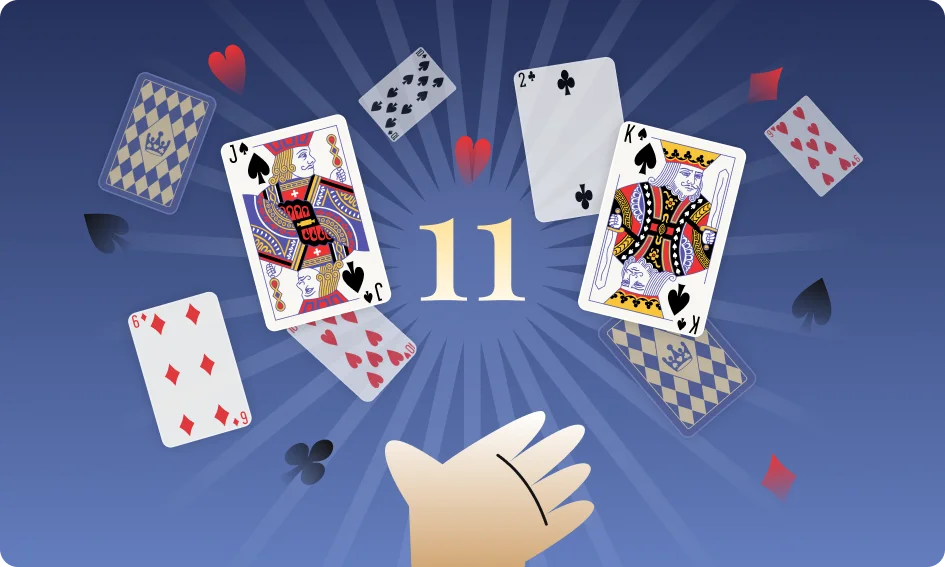Nowadays, many people like to wind down by playing video games after a hectic day of work. I prefer sitting down for a nice game of Solitaire (either alone or around a table with some friends). A nice hot cappuccino will be involved as well. I find it amazing how we can derive so much entertainment and create such fond memories from just a pile of cards.
Of all the card games available, I love playing Solitaire the most. It is not only a fairly intricate game but also never gets boring due to the numerous variations. If you’ve been getting a bit bored playing classical Klondike Solitaire, then there are some noteworthy variations. These are sure to keep your Solitaire experience fresh and stimulating.
1. FreeCell Solitaire
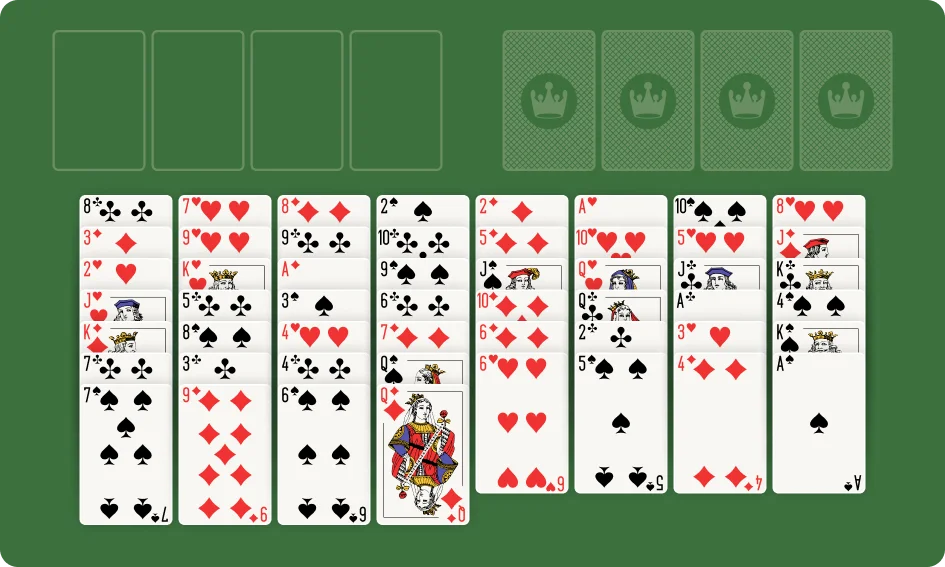
| Difficulty level | 5/10 |
| Strategy involved | 7/10 |
| Player mode | Single-player |
| Deck configuration | 52-card deck |
The first entry in our list is FreeCell Solitaire. This is a fairly deterministic variation, where almost every possible deck permutation can be solved. Does that mean that you’re expected to memorize every possible solution? Absolutely not. Initially, the fun part is accumulating experience. The payoff is when you come across the exact permutation later on down the line.
The best tip I can give you is to focus on making Aces and Deuces accessible. The quicker they become accessible, the easier it’ll be to build those satisfying foundation piles.
2. Spider Solitaire
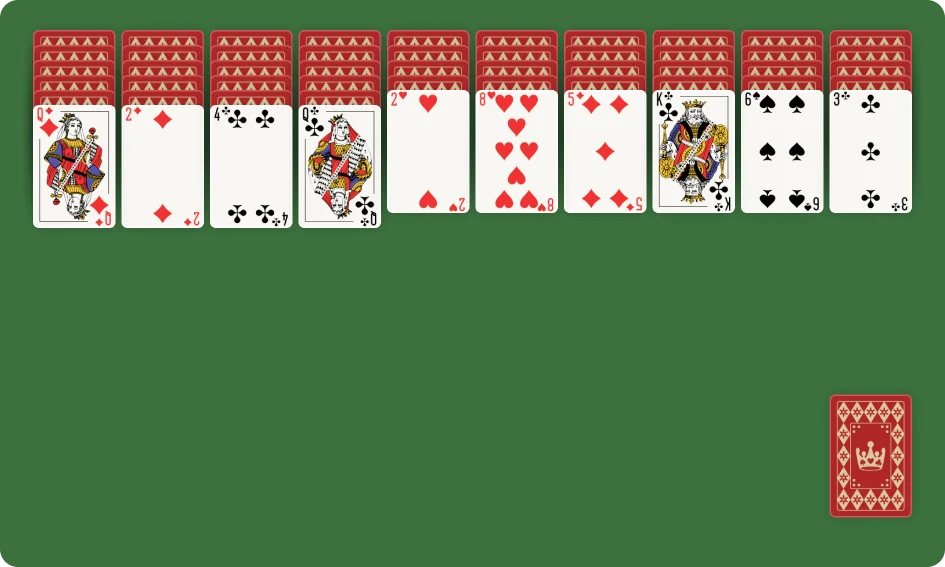
| Difficulty level | 8/10 |
| Strategy involved | 9/10 |
| Player mode | Can be played alone or with friends |
| Deck configuration | Uses multiple decks (up to four, depending on how you play it) |
Second on our list is Spider Solitare. This is an interesting variation, one whose difficulty can be tuned depending on which version you want to play: 4 Suits, 2 Suits, or 1 Suit (where 1 Suit is the easiest). My friends and I usually like to warm up with 2 Suits before getting down to some serious gameplay with the 4 Suit option. The tips I’ll provide mainly apply to the 4 Suits version because the other two are comparatively easy.
Make sure to prioritize uncovering hidden cards. This can unveil new moves but also contribute to unveiling an empty pile. Be sure to exercise restraint and build on top of high-ranking cards, even if it means that you make little initial progress. Patience is the name of the game.
3. Klondike Solitaire

| Difficulty level | 5/10 |
| Strategy involved | 6/10 |
| Player mode | Typically played solo but can be played with friends after changing a few rules |
| Deck configuration | Standard 52-card deck |
Klondike Solitaire is another variant worth checking out. Although often played by beginners, this game is actually quite difficult. Many setups simply aren’t solvable no matter how hard you try.
Much aptitude comes from raw experience. But, I should point out that your very first move can make a big difference. I always turn up the top card in the stock pile for my very first move. Doing so opens up more moves at the outset.
4. Accordion Solitaire
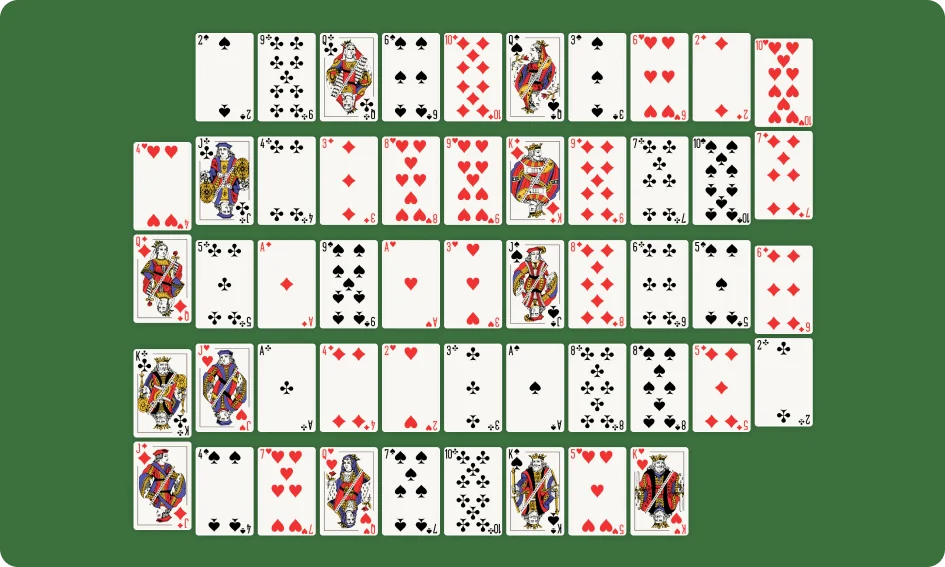
| Difficulty level | 6/10 |
| Strategy involved | 7/10 |
| Player mode | Single-player |
| Deck configuration | 52-card deck |
If you love the classic Klondike game, then Accordion Solitaire is a must-try. Unlike the traditional objective of moving all the cards to a foundation, winning in Accordion Solitaire means compressing all the cards into a single pile. Does that sound easier? If it does, then wait until you get into your first game. You’ll realize just how challenging the objective is (even if challenges can sometimes be fun). In this variant, there is a limited number of moves and unpredictable card arrangements.
I suggest focusing on uncovering hidden cards, especially at the start. This can help you set yourself up for more options when it comes to matching and removing cards. When you remove cards, use the empty spaces left behind wisely (such as creating those satisfying sequences). Don’t rush to fill them up.
5. Montana (Gaps)
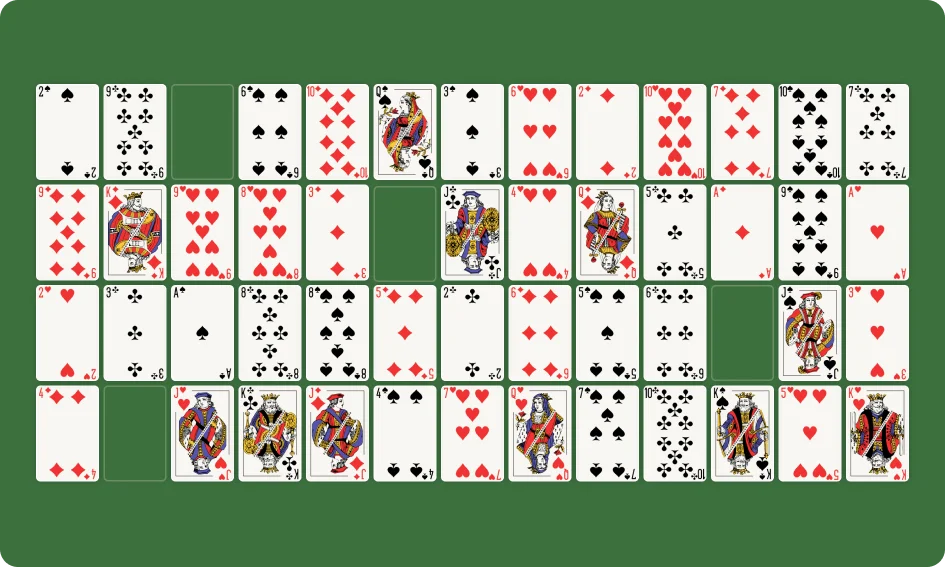
| Difficulty level | 7/10 |
| Strategy involved | 8/10 |
| Player mode | Can be played alone or with friends |
| Deck configuration | 52-card deck |
You might find that Accordion strays too far from the classic Klondike version. Perhaps, you want to play the same game while challenging your friends with a different foundation setup, tableau layout, and set of rules. If so, then Montana (Gaps) is worth a try. It’s quite straightforward. But, I’ve found that it requires a few test games to get the hang of things. At first, I found the fact that you can build the tableau in any suit mind-boggling.
At a glance, it might seem that Montana allows for increased flexibility. But, don’t get tricked into taking the game lightly (like I did the first time I encountered it). I’ve realized that it can be difficult to create sequences or move cards around without considering suits. So, practice the game a little. And, always remember that the ultimate objective is completing the foundation.
6. Carpet Solitaire
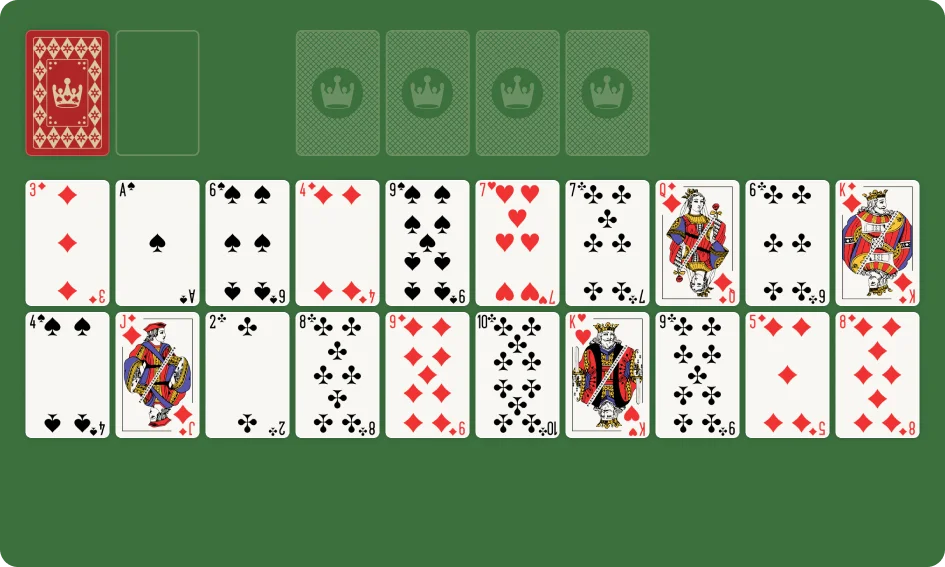
| Difficulty level | 5/10 |
| Strategy involved | 6/10 |
| Player mode | Can be played alone or with friends |
| Deck configuration | Two standard 52-card decks |
If you’ve been feeling a little adventurous lately, then you might want to try out Carpet Soltiare (also called “the Russian Carpet”). This variant gets its name from its unique carpet-like setup (resembling a grid). This grid-like setup can, however, impede those who are used to classical Soltiare because there are added blocking ramifications involved in moving even a single card.
But, if you’re up to the challenge, then you can follow this simple strategy: Aside from targeting empty spaces, try to build sequences that you can play consecutively. Don’t worry about higher- or lower-ranking cards in the discard pile. You can implement them later when needed.
7. Crescent
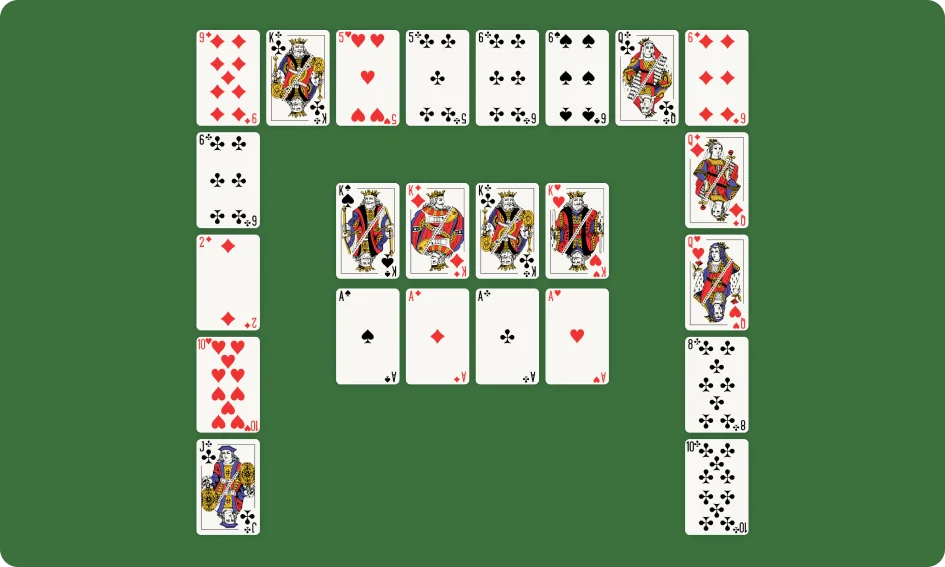
| Difficulty level | 7/10 |
| Strategy involved | 8/10 |
| Player mode | Can be played alone or with friends |
| Deck configuration | 52-card decks |
If you’ve tried out the aforementioned Solitaire variations and found them too easy, then Crescent Solitaire might be the challenge you’re looking for. Why “crescent”, you may ask? The game is played with two decks mixed together, where you deal cards in such a way that they form an arc or crescent.
If you (and your friends) want to really test your mettle, then good luck building ascending and descending sequences simultaneously. Not much can be said when it comes to strategy. Just keep in mind that it’s normal to reshuffle in Crescent Solitaire. So, don’t hesitate when push comes to shove.
8. Baker’s Dozen
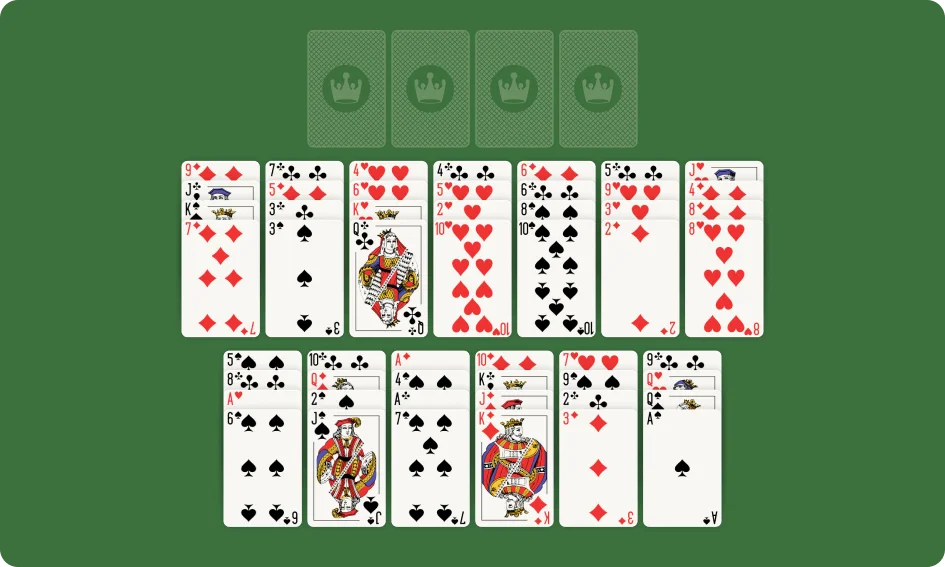
| Difficulty level | 9/10 |
| Strategy involved | 8/10 |
| Player mode | Single-player |
| Deck configuration | 52-card decks |
Baker’s Dozen is one of those Solitaire variants that really changes things up. You’ll think that you’re playing a completely different game. Just one look at the board and you’ll ask yourself, “What is this?” To demonstrate the game’s complexity, note that all cards are dealt face up into 13 columns. The objective is to build not one but each foundation from Ace to King! If that sounds daunting but also tempting, then you’ve passed the first hurdle.
Here are some key tips I wish I had known when starting out with this Solitaire variant. First, use empty spaces wisely. I like to use them to temporarily hold cards I plan to use later. Second, I can tell you from experience that you’ll almost always have to rearrange piles for match-ups. So, you need to be mentally prepared for that.
9. Forty Thieves
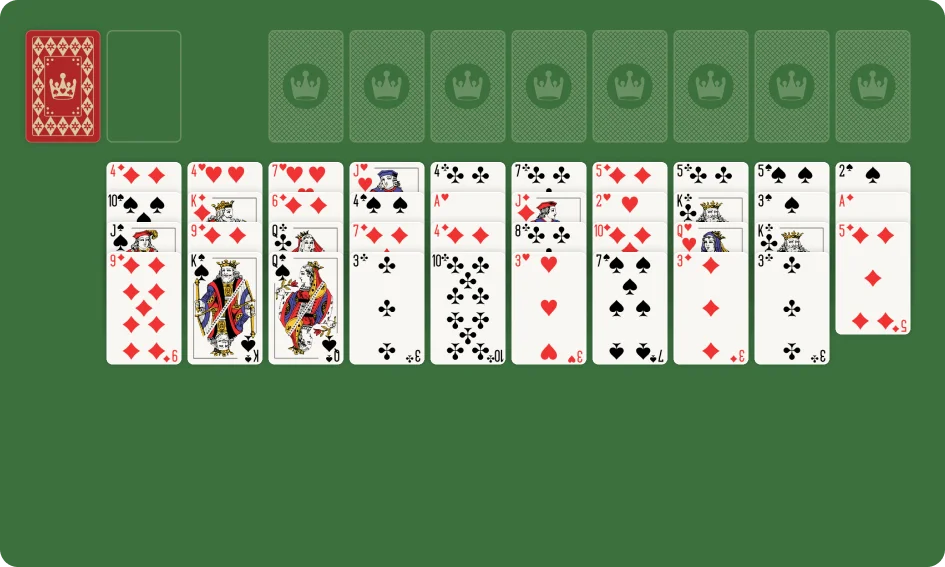
| Difficulty level | 9/10 |
| Strategy involved | 8/10 |
| Player mode | Single-player |
| Deck configuration | 52-card decks |
Although an innovative game, Forty Thieves is considered easier than Baker’s Dozen. So, it’s a good variant to opt for if you (and your friends) want to dial things down a notch. Instead of 13 piles, you have 10 piles. You must move all of the cards to the four foundation piles (one for each suit) in ascending order from Ace to King. The tricky part is the stricter building rules. For example, the sequence of columns should be in descending order.
If you implement the tips I mentioned for Baker’s Dozen, then you should be able to master Forty Thieves in no time. Nonetheless, here is an additional tip: Avoid building on the foundations unless absolutely necessary. Speaking from personal experience, doing so usually comes back to bite you.
10. Yukon
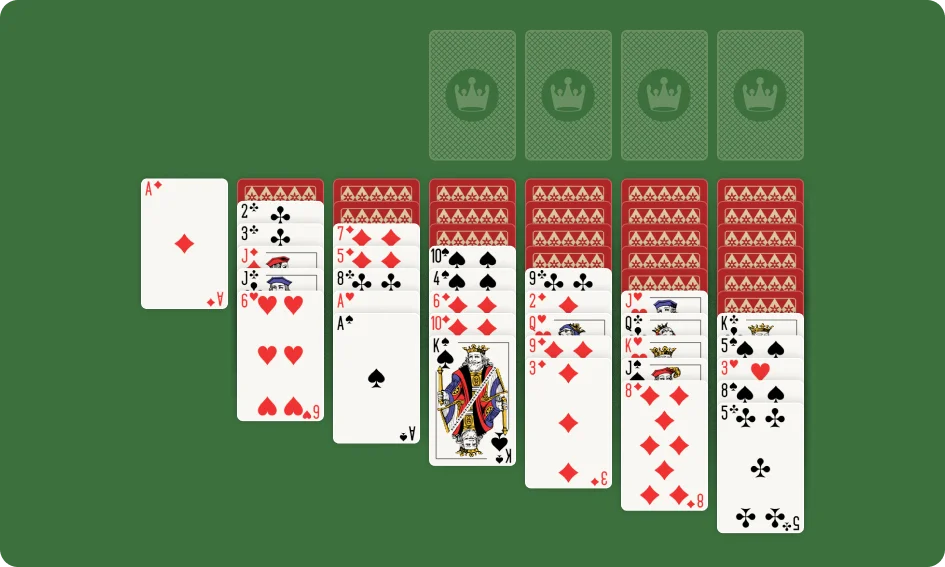
| Difficulty level | 7/10 |
| Strategy involved | 7/10 |
| Player mode | Single-player |
| Deck configuration | 52-card decks |
As we hone in on the last variant in this list, let’s take a moment to appreciate Yukon, one of the most well-known types of Solitaire. I enjoy playing it most with friends due to its neat balance of complexity and difficulty. I especially enjoy setting up the game in the manner depicted in the image above. The most enjoyable part is, however, when I actually get down to building those four foundations.
I have a high win rate on Yukon. So, I like to think of myself as an authority of sorts. I suggest that you prioritize uncovering face-down cards as soon as possible. The sooner you uncover them, the sooner you’ll be able to complete the foundation piles up.
11. Monte Carlo Solitaire
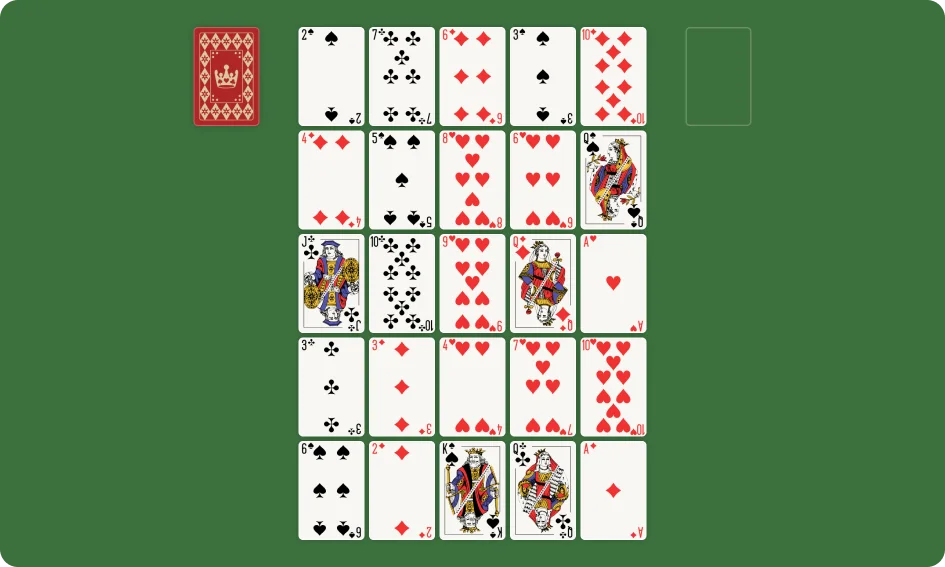
| Difficulty level | 8/10 |
| Strategy involved | 8/10 |
| Player mode | Single-player |
| Deck configuration | 52-card decks |
I’ve been looking forward to talking about this game. My favorite out of all the Solitaire variations is Monte Carlo. The game gives the illusion that luck is an important factor but strategy makes a huge difference when it comes to securing victory. Even when I lose at a game of Monte Carlo, I feel content knowing that I have accumulated important experience.
While playing over a hundred games, I’ve learned to be patient, specifically when it comes to removing pairs. Don’t rush to remove adjacent pairs of cards whenever you see them. Think ahead. Sometimes, leaving those cards on the board will allow more powerful moves to emerge later. I had to learn this the hard way, but now I realize just how invaluable this trick is.
Conclusion
There are many different types of Solitaire games out there. Each has its own set of rules and challenges. As such, you’ll have plenty of opportunities to sharpen your skills and enjoy your game time. Whether you are a Solitaire veteran or a newcomer, the wide variety of Solitaire variants ensures that there’s always something new to explore with a simple deck of cards!

